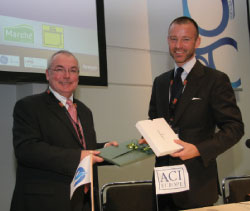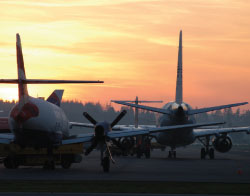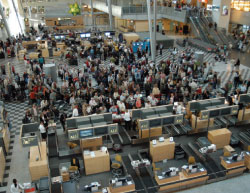
David McMillan, Director General, EUROCONTROL and Olivier Jankovec, Director General, ACI EUROPE, signed the cooperative agreement between the two organisations at ACI EUROPE's Airport Exchange event in Berlin in October.
The previous studies produced back in 2001 and 2004 by EUROCONTROL detailed the challenges resulting from the evolution of demand for air transport and provided a unique outlook on the future of European aviation. Analysing data and projections submitted by various industry sources, they are to-date the only reports looking at both demand trends and all related constraints from a pan-European network perspective.
Yet, these studies have not necessarily influenced to the fullest the policies and actions of the EU, especially when it comes to airport capacity. Indeed, although the 2004 Challenges to Growth study did send a warning signal about a looming airport capacity crunch for Europe, it is only since 2007 that the European Commission has started tackling the issue with its formal Communication on airport capacity, safety and efficiency. This may now be changing.
Airport capacity: a key challenge
By inviting EUROCONTROL to announce the preliminary results of its 2008 Challenges of Growth study at Airport Exchange, ACI EUROPE sought to enhance the visibility for this new report, especially as it unambiguously confirms that Europe continues to face an airport capacity crunch in the coming 20 years.
Based on a conservative scenario whereby the growth of demand for air transport will be limited by increasing regulatory constraints and economic slowdown, EUROCONTROL expects that the number of flights in Europe will double between now and 2030 to 20,4 millions, and that about 11% of these flights (2,3 millions) will not be accommodated due to a lack of matching airport capacity. This worrying outlook involves 19 European airports totally saturated with more than half of the total flights handled by the European network passing through one of these airports.

ACI EUROPE and EUROCONTROL will work on implementing essential enhancements such as collaborative decision-making at more than 40 European airports. A joint action plan with clear objectives and deadlines will pave the way for a coordinated approach by airports across the continent.
This means that Europe will face an unprecedented level of congestion and delays. As David McMillan, Director General of EUROCONTROL put it at Airport Exchange: “We are talking about the complexities and consequences of having to deal with 19 airports operating at a level of congestion similar to that of London-Heathrow today!”
But what should even reinforce causes for concern is the fact that these conclusions assume that European airports will be in a position to deliver in time all planned capacity developments, thus allowing for a 41% airport capacity increase by 2030. Given the increasing difficulties that airports are facing in planning, financing and delivering capacity expansions, such assumption appears to be quite optimistic. As a result, the level of unaccommodated flights and the resulting congestion may be even worse than presently forecasted.
Four other Challenges
Apart from airport capacity, Challenges of Growth identifies 4 other challenges for the future of European aviation:
- Environmental impact: Difficult trade-offs will be required – and these are not just between growth and environmental impact but also between CO2 emissions, noise and local air quality.
- Operating a congested network: There could well be a demand for flights that airports just won’t be able to meet. Airports are a significant part of the network: if airports do not have enough capacity, the network as a whole will be vulnerable to perturbations – and less able to recover quickly from them.
- Institutional and social changes are needed so that SESAR (the Single European Sky’s technical programme for the future air traffic management system) can deliver enhanced air traffic capacity – on time. “We’re thinking here of the changes in mindset needed for Europeans to adopt the thinking behind SESAR – sharing airspace; building Functional Airspace Blocks, and the like,” said McMillan.
- Climate change will affect demand for travel and possibly cause problems for airports and flights.
Like the preceding Challenges studies of 2001 and 2004, the objective of the 2008 Challenges of Growth study is to provide decision-makers with up-to-date assessments of the challenges facing air transport. “All those involved in air transport now need to reflect on how they will address the different issues” said McMillan.
ACI EUROPE/EUROCONTROL Cooperation Agreement
The wide-ranging cooperation agreement on airport capacity signed by ACI EUROPE and EUROCONTROL on 28 October 2008 aims precisely at making an active contribution to addressing some of these issues. The partnership commits the two organisations to jointly enhance the capacity of airport infrastructure across Europe, in particular through collaborative ground processes between airports, airlines and ATC. A joint Action Plan on Airport-Collaborative Decision Making (A-CDM) has already been launched, with the objective of engaging and piloting 42 European airports in its implementation by the end of 2009. The benefits are clear: based on the precedent of Munich airport, where A-CDM is now fully operational, the joint Action Plan aims at achieving a reduction of more than 475,000 tons of CO2 per year, which will in turn generate some €120 million in cost savings for airports and airlines.
Figures like those are music to the ears, all the more so, when the current economic and financial crises are wreaking havoc on the sector. With passenger and freight demand falling across many markets for the first time since 2001/2002, airlines’ revenues have been badly hit this year. Improvements that can be made in ground operations translate into efficiency and often savings for them, which in turn can potentially help airports reducing the risk of frequency reductions or route closure. These improvements also have environmental benefits, reducing the impact of airport operations, especially in terms of emissions. Finally, they also place airports in a better position to defend necessary infrastructure developments, a very important issue in the context of the airport capacity crunch that Europe continues to face in the medium-term.

A-CDM is now fully operational Munich airport – for an airport of this size, currently a 10% reduction of taxiing times is achievable, which equates to an estimated 53.6 million in cost savings for the airport and the airlines.
The cooperation between ACI EUROPE and EUROCONTROL will also be looking at airport capacity from a strategic perspective. The partnership will enable a coordinated approach to addressing the many capacity challenges highlighted in EUROCONTROL’s 2008 Challenges of Growth. Olivier Jankovec, Director General of ACI EUROPE said: “Our cooperation aims at addressing crucial short-term and long-term challenges for European aviation.
Ultimately, we all know that optimising airport capacity will not be enough and this new EUROCONTROL study again sends a warning signal about the need for new infrastructure”. Both organisations also recognise that airports need to be better integrated into the ATM network, and that they need to develop a better understanding of and buy-in to SESAR and the Single European Sky project (SES). This involves the need to align airport and ATM capacity objectives at European level, a long time request from ACI EUROPE.
EU Observatory on Airport Capacity
Both the preliminary results of Challenges of Growth and the signature of the cooperation agreement between ACI EUROPE and EUROCONTROL provided the ideal background for the first meeting of the EU Observatory on airport capacity, which took place on 4 November 2008. Referring to this first meeting McMillan indicated that: “Obviously, the Observatory will be a focus for addressing the airport capacity challenge identified by Challenges of Growth. Inside EUROCONTROL, we will be looking in more detail at what we need to do to ensure that the network is agile enough to deal with the changes in patterns of demand we expect.”
The EU Observatory on Airport Capacity was initially proposed by the European Commission in 2007, together with its Communication on airport capacity, safety and efficiency. However, it is only with the recent re-launch of the Single European Sky that the decision to establish it was taken. The Observatory brings together all interested parties including EU Member States, EUROCONTROL, airports (represented by ACI EUROPE), airlines, slot coordinators, etc. Working strictly as an advisory body, it will provide non-binding opinions to the European Commission as a basis on which it could develop further policy on airport capacity. “The Observatory has been put in place for an initial period of five years, which coincides with the SESAR Development Phase. I think it is a unique forum for exchanging data and information on airport capacity and for ensuring that the European Commission is in possession of all the information it needs in order to develop an optimal legislative framework for Europe’s airports,” said McMillan. He added “Given its membership, it is well placed to assist and advise the European Commission on the best strategy for delivering increases in capacity and match the growth in demand, while ensuring that the impact of aviation on the environment is reduced as much as possible.”

One of the five Challenges highlighted in EUROCONTROL’s newly released 2008 study is environmental impact; difficult trade-offs will be required – and these are not just between growth and environmental impact but also between CO2 emissions, noise and local air quality.
The first meeting of the Observatory afforded a review of the general structure and organisation of the work ahead. Three working groups have been established: Working Group for an inventory of Airport Capacity at EU level – chaired by EUROCONTROL; Working Group on intermodality – chaired by Airport Regions Conference (ARC); and Working Group on Gate-to-Gate issues – co-chaired by ACI EUROPE and EUACA (European Association of Slot Coordinators).

By 2030, it is expected that 19 airports will be operating at full capacity for eight hours or more a day, and about half of flights will pass through one of these airports.
The Observatory will be chaired by the European Commission, with EUROCONTROL as Vice-Chair. “As far as EUROCONTROL is concerned, a high point of the first meeting was that the Agency was nominated as Vice-Chair of the Observatory. The fact that this was fully supported by ACI EUROPE is another excellent example of our increased collaboration and mutual trust,” said McMillan. “EUROCONTROL will be leading the work on capacity assessment and over the coming months we will be examining how to carry out a comprehensive capacity inventory in Europe. For this to be a success, we will need the ongoing support of ACI EUROPE, as well as of the airports themselves.”
Commenting on this first meeting, Daniel Calleja, Director Air Transport Directorate, European Commission, explained that discussions confirmed there is a need to better assess available airport capacity from a network perspective rather than through a simple juxtaposition of local particularities. The lack of airport data at EU level was also stressed, as well as the necessity of improving the environmental compatibility of airports. “I am convinced that, thanks to the collaboration of all interested parties, and to the quality of the work that will be carried out, the Observatory will be in a position to fully play its role, and will usefully advise the Commission on suitable ways to implement the action plan for airport capacity, efficiency and safety in Europe,” he said. “In other terms, the Observatory is bound to be a key instrument to address the challenges which the European Union will have to face in the future.”
ACI EUROPE is hopeful that the Observatory will play an important role in giving more visibility to the airport capacity at EU level and potentially incentivise Member States to consider not only local implications but also national and even European ones when it comes to take decision on much needed capacity developments.







